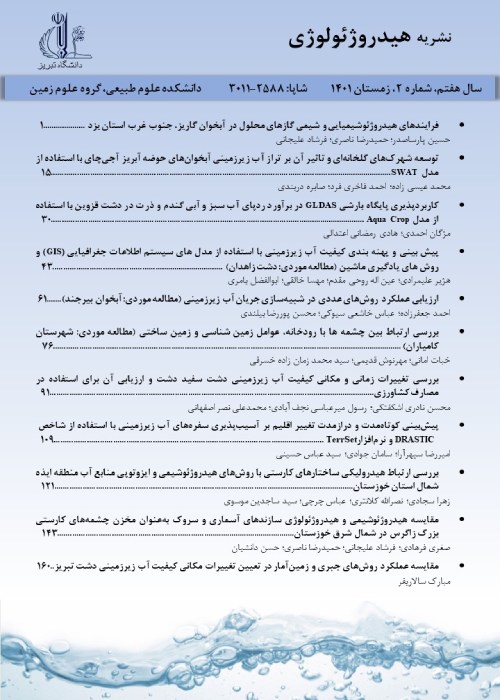Using of Water Pressure Test Results to Calculate of Seepage through Grouting Curtain of Seymareh Dam at Ilam Province of Iran
Since Maurice Lugeon (1933) invented the water pressure test (Lugeon), it has been recognized as the best method to evaluate hydraulic conductivity (permeability) of rock masses. One of the main advantages of this test is its simplicity, easy measurement of required parameters and simplicity of interpretation. In this research water pressure test (WPT) has been used to evaluate of seepage from grout curtain at Seymareh dam. The dam is constructed on Seymareh River at Ilam Province. Dam site is located 40 km northwest of DarehShahr and 95 km southeast of Ilam. The geographical coordinates of the Seymareh dam are located at 47° 12' 7" East and latitude 33° 17' 32" North. The Seymareh dam Power Plant site is located 1.5 km from the Dam site (Fig 1). The study area is geologically located in the southwestern part of the Zagros fold and consists of relatively high mountains with a general northwest – southeast trend. The low-lying straits that the Seymareh River created during its erosion are one of the morphological features of these areas. The rock masses of the dam and power plant and all structures associated with the Seymareh Dam belong to the Asmari Formation. Three units of this Formation can be identified as follows: Upper Asmari: This unit is outcropped in the upper parts of the Ravandi anticline and inlet of the valley. The thickness of this unit is 50 to 55 meters. Middle Asmari; In general, the middle Asmari unit is about 220 meters thick, with small karstic effects evident. Lower Asmari: This unit has a slight outcrop downstream of the diversion tunnel outlet and near the Ravandi anticline. This unit is about 12 meters thick from the riverbed (Fig.2). Fig.1: Location of Study Area in Ilam Province Fig.2: Geological map of Seymareh Dam site Above the Asmari Formation, the Gachsaran Formation (Miocene-Pliocene) is exposed. These sediments are composed of siltstone and red and green marl between thin gypsum layers and fossilized limestones.Gypsum was replaced by anhydrite at certain times and thick salt layers were sometimes found. The recent or quaternary sediments in the study area include coarse-grained alluvial sediments, fine-grained lake sediments, debris sediments, and old alluvial sediments of the Seymareh River that formed in varying thicknesses along several river paths (Fig. 2).
Over the past few decades, there has been a great deal of effort to develop methods of calculating seepage in rock masses, most of which are based on calculating water flows at fully open joints using hydraulic laws and then comparing them with performance measurements in mathematical models. From the point of view of rock mechanics, the seepage in the rock can be estimated based on calculations of theoretical methods whose accuracy is confirmed in model experiments. By definition, one Lugeon is equivalent to one liter of water per minute for one minute at one meter of borehole under 10 atmospheres pressure. The definition of Lugeon is shown in the following formula (Eq. 1):(1) By converting units and simplifying the face and denominator we will deduct (Eq.2):(2) If the right-hand side of Equation 2 is multiplied by the fluid dynamic viscosity, then the intrinsic permeability of the environment is obtained for the numerical value of one Lugeon value (Eq. 3) (water dynamic viscosity of approximately 0.01 (dyne.s. cm2-1) , N is Lugeon value). (3) There is a relationship between hydraulic conductivity (k) and intrinsic permeability ( ) (Eq. 4): (4) Therefore, the hydraulic conductivity for one Lugeon value will be as follows (Eq. 5, Eq. 6): (5) (6) In order to estimate the hydraulic conductivity of the Seymareh Dam, the WPT results were analyzed in 244 boreholes at 4331 stages. Of these, 123 boreholes and 2254 stages were related to control boreholes (after the execution of the grout curtain). Also, before the execution of the grout curtain, 1277 stages boreholes were calculated in 121 boreholes and the hydraulic behavior of each stage was determined. The Lugeon value of each stages converted to hydraulic conductivity using Equation 6. Using equations 7 and 8, the horizontal (kx) and vertical (kz) hydraulic conductivity values are calculated in each borehole: (7) (8) In equations 7 and 8, k1 represents the hydraulic conductivity of the first stage and z1 represents the length of the same stage and z represents the total borehole length.
The main purpose of this study was to evaluate and compare the grout curtain leakage rate with the calculation method of hydraulic conductivity obtained from the WPT (Lugeon test) and the direct measurement of discharge at drainage galleries. Accordingly, the grout curtain is divided into different zones and after obtaining the average depth of the grout curtain and calculating the hydraulic conductivity of exploratory and control boreholes in each zone, the amount of leakage before and after the grout curtain execution is calculated. . The total leakage from different parts of the galleries indicates the total leakage from the grout curtain executed at the dam site. Determining the average hydraulic conductivity (k) and the average depth of the boreholes (b) in each zone, the transmissibility (T) for each zone is calculated and with determining the gallery length in each zone, the total amount of leakage (Q) for each zone is estimated. According to the calculation, the leakage rate of the Seymareh dam grout curtain is based on tests performed before and after the grout curtain execution for a reservoir with a water level of 720 m.a.s.l equals 560 and 212 liter per Second. Therefore, it was found that the execution of the grout curtain reduced the amount of leakage in the Seymareh Dam by 62%. The behavior of fractures and joints in a borehole can be interpreted by a WPT in which a series of effective pressures are applied to the borehole sections. The Lugeon values obtained for the pressure steps of a stage test can, in sum, indicate the relative number and size of joints and fractures, the suitability of the maximum design pressure, and the tendency of the joints to be leached by flow pressure. Since the injection operation changes the hydraulic behavior of the rock, the hydraulic behavior of all sections was investigated before and after the grout curtain execution. The results show that 8% of stages have wash out behavior before grout curtain execution and 10% of stages show wash out behaviors after grout curtain execution. Also, 4% of the sections had void filling behavior prior to grout curtain execution, and 5% of the stages showed void filling behavior after the grout curtain execution. In dam construction projects, the actual discharge from the dam curtain is measured based on the drainage holes discharge. For the validation of the calculated real leakage number, drainage borehole discharge data have been estimated. The total discharge of drainage in full open valve was 211 liters per second. Since at the time of drainage discharge measurement in fully open valve, the reservoir water was at level 698, for verification, the leakage calculation based on level 720m.a.s.l was calculated again based on level 698m.a.s.l. According to the calculation, the leakage rate of the Seymareh dam grout curtain is based on tests performed before and after the grout curtain execution for a reservoir with a water level of 698 m.a.s.l equals 441 and 193 liters per Second. Drainage discharges are usually influenced by two basic factors: 1 - The amount of water that passes through the grout curtain. 2 - The amount of water that moves down behind the grout curtain and leaks under the grout curtain. In the case of seepage under the dam, only the vertical hydraulic conductivity (kz) of the lower dam galleries is effective. Whatever the vertical hydraulic conductivity of the upper levels, the seepage under the grout curtain is proportional to the potential for vertical overburden. Based on the leakage calculations of the exploratory boreholes (before the grout curtain execution), the total vertical leakage of the galleries is 8 liters per second. As mentioned, based on the analysis of the Lugeon test results after the grout curtain execution, ten percent of the wash out behavior sections show that they will theoretically increase the leakage by 10 percent over time (+ 10%). Also, five percent of void filling behaviors indicate that they will theoretically decrease leakage by 5 percent over time (-5%). The difference between the two can be seen as an increase of five percent over time. Also, based on the analysis of the Lugeon test before the grout curtain execution, eight percent of the sections show wash out behavior that theoretically will increase the leakage by 8 percent over time. Also, four percent of the stages show void filling behavior, which theoretically will reduce the leakage by four percent over time. Comparing the two can predict a four percent increase in leakage over time. The amount of drainage discharge at the Seymareh Dam when the reservoir level is 698 m is calculated as follows: Drainage discharge = (grout curtain leakage+ 5% leakage) + (seepage under grout curtain + 4% leakage) Drainage discharge (reservoir level 698) = (193×1.05) + (8×1.04) = 202.65 + 8.32 = 210.97 = 211 Ls-1 The calculated number corresponds to the measured real number, which indicates very high accuracy of the model. This is for two reasons: 1- The boundary conditions in the model are well considered and 2- The equation presented in this study for converting the Lugeon value to hydraulic conductivity is highly accurate.
The following results have been obtained WPT in the rock formations of the Seymareh Dam site: 1- By performing the Lugeon test, the intrinsic permeability of the environment can be directly measured. 2- Comparison of the results obtained from the calculation of leakage from this relationship with the measured leakage from drainage galleries indicates the appropriate accuracy of the obtained relationship in this study. 3- The results of direct measurements of the leakage from downstream galleries show that the grout curtain executed in the Seymareh Dam is of good quality and has been effective in reducing leakage (about 62%). 4- In analyzing the leakage at the dam site, one should also consider the hydraulic behavior of the rock and pay particular attention to the behavior of wash out and void filling because wash out and void filling behavior are both dependent on the passage of time. In areas with wash out behavior and void filling, the amount of water passing through these sections increases and decreases with time. Since increasing the number of WPT plays an important role to more accurate estimation of hydraulic properties and better evaluation of rock mass behavior against water flow, it is recommended some Lugeon test perform in the exploratory boreholes and check holes in each grout gallery.
- حق عضویت دریافتی صرف حمایت از نشریات عضو و نگهداری، تکمیل و توسعه مگیران میشود.
- پرداخت حق اشتراک و دانلود مقالات اجازه بازنشر آن در سایر رسانههای چاپی و دیجیتال را به کاربر نمیدهد.




